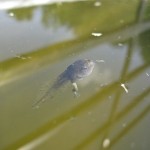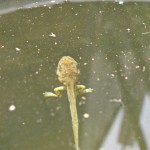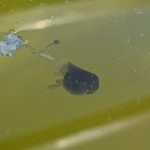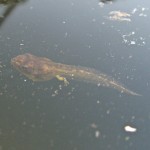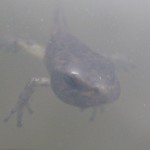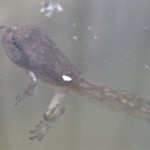Several weeks ago I noticed that our horses’ stock tank had been inhabited by tadpoles! If you are not familiar with stock tanks they are large (110-gallon capacity), oval-shaped galvanized water tanks designed for livestock. Apparently tree frogs had climbed into the tank and laid their eggs. It’s been very dry here this summer and most of Indiana has been classified as a drought area. Our pond has long since disappeared and there are very few places, if any, available for breeding. I guess the stock tank seemed like a nice place to propagate the species! After all, it is filled with non-chlorinated water from our well and there is plenty of room for a few dozen tadpoles.
Given the importance of frogs in the environment and the dire plight of amphibians worldwide, we wanted to make every attempt to ensure the survival of the tadpoles. Frogs can coexist with horses so we decided to let the tadpoles mature in the tank and climb out when they were ready. We refresh the tank each day to make sure that the temperature is tolerable and the water is oxygenated. When the horses drink they deposit hay and plant matter in the water which attracts insects, a food source for the tadpoles.
I thought it would be fun to document the development of the tadpoles with photos. This is sort of like the elementary school science project on the life cycle of frogs (It’s never too late to learn!). The tadpoles were too small to photograph soon after hatching so I waited until they began to develop their hind legs. At this stage the gills have been replaced by lungs. Eventually the front legs (forearms) will appear, the tail will shorten and the frogs will climb out of the tank to undergo a metamorphosis which will enable them to live on land. The first series of photos shows the transition from two to four legs which occurred at about 4-6 weeks (?) of age. If you examine the second photo in this series (tadpole dorsal) you will see two “bumps” located behind the eyes. These “bumps” mark the site of emergence of the front legs, elbow first.
Let’s all hope that the tadpoles reach maturity and we hear their wonderful song next spring!
Update
Shortly after the tadpoles developed four legs they disappeared from the stock tank. Unfortunately, we did not see the migration. We would like to think that they successfully made the transition to land and are thriving somewhere on our farm.
A Final note
If you are concerned about the fate of frogs and want to be informed, you need to read the Australian article by Dr. Sara Broomhall on “Frogs in an Effluent Society”. There is also an interesting article published recently by Raffel et al. (2012) on the possible effect of climate change on the threat of Chytridiomycosis, the parasitic fungus that is killing frogs worldwide.

